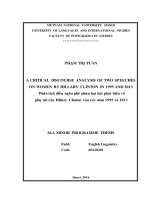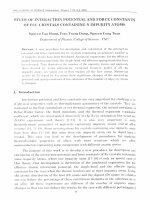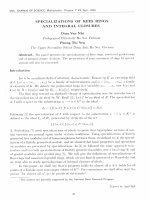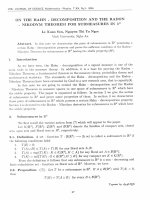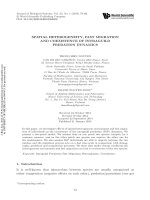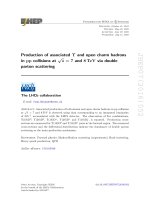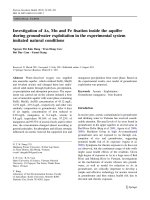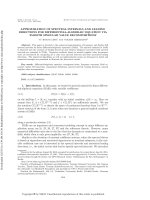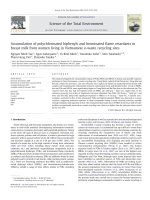DSpace at VNU: Grant Harman, Martin Hayden and Pham Thanh Nghi (eds): Reforming higher education in Vietnam: challenges and priorities
Bạn đang xem bản rút gọn của tài liệu. Xem và tải ngay bản đầy đủ của tài liệu tại đây (77.72 KB, 3 trang )
High Educ (2013) 65:781–783
DOI 10.1007/s10734-012-9551-2
BOOK REVIEW
Grant Harman, Martin Hayden and Pham Thanh Nghi
(eds): Reforming higher education in Vietnam:
challenges and priorities
Springer, Dordrecht, 2010, 23 pp
Thi Tuyet Tran
Published online: 21 July 2012
Ó Springer Science+Business Media B.V. 2012
Under the impact of globalization and the development of the knowledge economy and
information technology, many countries in the developing world are struggling to reform to
develop modern higher education systems (HES) to meet the new needs of industry and to
increase the competitiveness in the knowledge market. Many innovation movements initiated in the West such as internationalisation, privatisation, marketisation or the cooperation with industry are now adopted and have become major focuses of higher education
(HE) reform in many developing countries.
Grant Harman, Martin Hayden and Pham Thanh Nghi’s book, which focuses on HE
reform in Vietnam is a welcome contribution in this area, as it introduces and addresses
quite details recent reforms in the HES of a developing country in South East Asia. With
the contribution of both Vietnamese and foreign scholars, the book has brought both local
and international perspectives on various aspects of the Vietnamese HES. Centered by the
Higher Education Reform Agenda (HERA) promulgated by the Vietnamese centre government, however, the main focus of the book is not on presenting the government’s vision
of what the HES is expected to become, but on the challenges it has to face in order to
reach that goal. The goal, as suggested in HERA, is:
To carry out fundamental and comprehensive reform of HE; undertake a process of
profound renews in the area of the quantity, quality and effectiveness in order to
met all the demand for learning opportunities. By 2020, Vietnam aims to have a HES
that is advanced by international standard, highly competitive, and appropriate to the
socialist-oriented market mechanism (pp. 51–52).
The book has 15 chapters which address most related issues related to the reform. The first
four chapters provide an overview of the Vietnamese HES, its history and plan for the
future and address various of the reform measures proposed in HERA. The detail
discussion reveals the low level of development of the system with too many internal
T. T. Tran (&)
La Trobe University, No. 1 Malpas Street, Preston, Melbourne, VIC 3072, Australia
e-mail: ;
T. T. Tran
Vietnam National University—Hanoi, Hanoi, Vietnam
123
782
High Educ (2013) 65:781–783
problems needed to be settled. This ‘dark’ picture does not seem to support the ambitious
HERA. There appear significant challenges or gaps between the official aspirations and
realistic expectations, between the desire to develop an internationally competitive HES
and the background of a system lacking sufficient funding, a system of low quality teaching
and learning and weak research capacity with strict controls and centralized governance
from the centre ministry and the government.
The followed 11 chapters discuss these challenges in details. Chapter 5 discuss the
quality of teaching and learning in HES in Vietnam and suggests that it is of no hope to
enhance teaching, learning and research quality without much more investment in academic staff, i.e. to upgrade their qualifications, increase their salary, reduce teaching loads,
provide training and rewards to create a positive research environment in HE. Following
this suggestion, chapter 6, 7 and 8 bring about a clear picture of research and research
commercialization in Vietnamese HE. It is suggested that when research is not part of HE
culture in Vietnam, when the understanding of intellectual property is still very limited
among academic staff and students and when academic staff have too little experience with
ways of commercializing scientific knowledge, attaining HERA’s reform ambitions and
Vietnam’s aspiration to achieve industrialized country within the next few years (by 2020)
seems to be a significant challenge for the whole system.
Chapter 9, 10 and 11 each presents a different way to address the problem of HE
governance and management in Vietnam. However, the message that the authors of these
three chapters want to deliver seem to be similar that HERA involves a large number of
overly ambitious and impractical objectives, given the strict, but also the weak capacity to
manage the whole system of the central ministry, the lack of understanding and experience
with institutional autonomy across the whole system as well as the lack of sufficient
resources and of an appropriate infrastructure for institutional self-governance. The
Vietnamese government, through HERA, seems to try to do too much too quickly. It aims
to develop an internationally competitive HES, while its internal problems have not settled.
Issues of equity, of quality accreditation, discussed in chapter 12 and 13, respectively, are
among internal problems urgently needing to address to better resource different types of
institutions and to control the quality of the internal system. The process of internationalisation and privatisation of HE in Vietnam, as discussed in chapter 14 and 15, also face
many hurdles. A system with non-public HEIs who remain inferior in status and who have
very little room to move within strict controls of the central ministry won’t satisfy the ever
growing demand for learning in the society, and thus, will leave much room for foreign
education providers. The internationalisation of HE in Vietnam seems to enhance
the tendency of ‘‘not just brain-drain! There is another term we should use… brain wash!’’
(p. 209).
This book is a valuable resource for education researchers and policy makers who want
to develop their understanding of the Vietnamese HES at the current stage of development.
Its value not only lies on the way it touches on the very current aspects and issues of the
system, on the rich information and the sharp and critical perspectives readers can
approach, but more importantly, it makes explicit many implicit matters that are normally
known and familiar by many Vietnamese scholars, but are not often articulated in print and
are out of easy reach of popular reader hood. On the other hand, this book is also a highly
recommended document for Vietnamese policy makers, as it will help them to obtain
objective and scholastic views, to reflect on the actual situation, and to develop a more
practical plan with a clear strategic planning and also to identify priorities in plan
implementing.
123
High Educ (2013) 65:781–783
783
Although the book focuses on the HES in Vietnam, its descriptions and discussions do
seem to evoke ponderings about common characteristics of HESs in many developing
countries, i.e. the lack of sufficient funding, the poor infrastructure for teaching, learning
and research, the weak research capacity of academic staff, the absent of research culture
in HE, the centralized HE governance and the lack of practical strategic planning to step by
step reform HESs. The book is highly recommended, then, for policy makers, scholars and
students of HE who want to benefit from the insights regarding not only Vietnamese HES,
but also policies aimed at reforming HESs in developing countries in the globalisation era.
123
